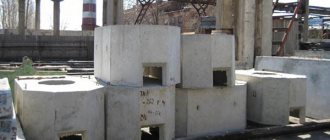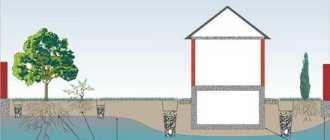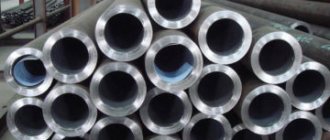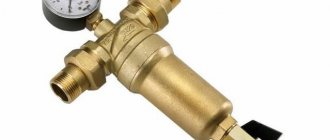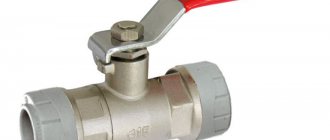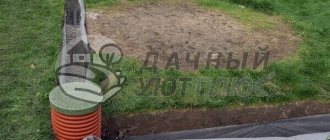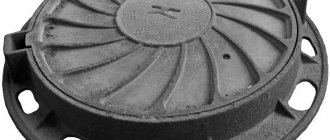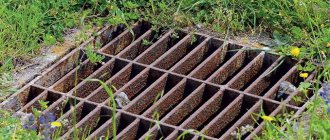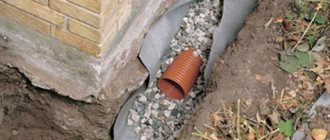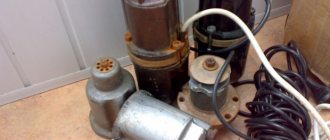Types of inspection drainage wells
Let's start with the fact that the inspection well used in the drainage system performs only two functions:
- Through it, the quality of drainage is monitored .
- The system is being .
As for the shape, wells on the market are represented by devices of round and rectangular cross-section. They can be installed in pressure and non-pressure drainage systems. But there are some installation subtleties in each individual case.
Rectangular viewing device Source int-vrn.ru
The two systems differ from each other in that a gravity system is a gravity system in which water moves under the influence of gravity. Pressure is a system that includes pumping equipment. It is this that pumps groundwater. In suburban construction, the first is most often used.
In essence, these are several straight pipe sections connected into one common system. The latter can be very complex, so it cannot be done without inspection wells. Therefore, they must be installed in the following cases:
- on straight sections ;
- at the point of connection of contours or their branching ;
- in the place changes ;
- at the point where the change in the slope of the laid drainage pipes begins;
- in the area where the direction of movement of groundwater is changed
Place of change in the direction of movement of drained groundwater Source oteplicah.com
It should be noted that in straight sections, inspection wells are installed at a certain distance from each other, taking into account the diameter of the pipes used. Here the dependency is like this:
| Diameter of drainage pipes, mm | Distance between inspection wells, m |
| up to 150 | 35 |
| 200-450 | 50 |
| 500-600 | 75 |
| 700-900 | 100 |
| 1000-1400 | 150 |
| 1500-2000 | 200 |
| more than 2000 | 250-300 |
It should be noted that all these indicators are recorded in SNiP 2.0403-85 under the title: “Sewerage. External networks and structures.”
As for the sizes of the manholes themselves, they are presented on the market in a standard size. And their diameter is selected to match the diameter of the drainage system pipes. The dependency is shown in the table below.
| Drainage pipe diameter, mm | Diameter of inspection well, mm |
| 100 | 600 |
| 125 | 700 |
| 150 | 800-1000 |
| 200 | 1200 |
If the inspection well is installed at the turning point of the system, then its diameter must be increased, because the movement of water in it will slow down. That is, fluid will accumulate and fill the well. Moreover, it is in such places that rapid siltation occurs.
Standard size of inspection wells for drainage Source bazartf.ru
When selecting, it is also necessary to take into account the depth of the wells. The thing is that it is not so easy to carry out cleaning and repair work through them. And if the depth is great, then a worker will need to go down into the well to carry out repair work. Therefore, if the depth of the well, which means the length of the well, does not exceed 1.2 m, then devices with a diameter of up to 700 mm can be used. If the depth is more than 2 m, then at least 1500 mm.
It should be added that devices with a small depth indicator are called inspection devices. The deep ones are called serviced ones. Note that wells with a diameter of more than 700 mm are equipped with ladders or brackets for comfortable descent inside.
Deep inspection wells are equipped with ladders Source sean-smith.net
Types of manholes for drainage system
There are only three types:
- linear
; - rotary
; - nodal
.
The latter are devices into which several drainage circuits are connected. They are installed in such a way that the secondary contours approach the main one at an acute angle.
Inspection well for nodal type drainage Source bilma.ru
See also: Catalog of small-form projects - bathhouses, gazebos, garages of any category and construction technologies
Manufacturing materials
Today, manufacturers offer inspection and storage drainage wells from three materials: concrete, plastic and composite. Concrete products (reinforced) have quite serious strength characteristics:
- resist the force
of buoyant
water
well ; - they can easily withstand
heavy
loads
; - low
price.
There is only one drawback - high specific gravity. Often, lifting mechanisms are used to install them. This means that you will have to organize an access route if, for example, a crane is used. Some manufacturers produce wells without through holes for pipes. Therefore, they have to be drilled on site, which is not so easy. And one more small minus - concrete is not a one hundred percent waterproof material.
Concrete inspection well Source tsk-kompozit.ru
In this regard, polymer wells and those made of composite materials are better. They are lighter, cost several times less, and are 100% waterproof. But the standard size of the devices is small - does not exceed 400 mm. But, as practice shows, this is sufficient when constructing a drainage system on a suburban area.
It should be added that plastic products are gradually replacing all others. There are several reasons for this:
- small
specific
gravity
; - 100% tight
; - a wide variety of
shaped
parts
; - quick and easy installation
.
But it is also necessary to take into account the fact that the load-bearing capacity of plastic devices is not the highest. In any case, in this characteristic they are inferior to both concrete and composite products. Therefore, when the task is to install inspection wells for drainage from gutters, which are installed near the roadway, then you should pay attention to the thickness of their walls. The bigger it is, the better.
Current installation requirements
When installing inspection wells, special attention is paid to the following parameters:
- In urban systems, the shaft must accommodate one adult with a set of tools.
- The main material for manufacturing hatches is cast iron for city communications and plastic for private sewers. The weight of a hatch located on the roadway is 134 kg, for sidewalks no more than 80 kg.
- The size of the neck must allow the use of cleaning devices.
Compliance with sanitary standards and installation rules allows you to avoid accidents and sewerage breakthroughs, as well as create conditions for the uninterrupted operation of monitoring equipment inside the pipeline.
Manhole installation technology
In principle, inspection wells are installed during the assembly of the entire drainage system. And to do this, you need to dig trenches in which drainage pipes will be laid, and decide on the location of the installation of wells: inspection and storage.
After which the installation of pipes begins. Usually they start from the foundation of the house, moving to a storage well, which is installed in the lowest place of the suburban area. The pipes are brought to the installation sites of inspection devices, where the latter are installed. It is clear that in such places extensions are made to conveniently carry out the required work.
They try to install the drainage system when the groundwater level is low. But even during this period, water may appear in trenches and pits. Moreover, the pit for the inspection well is usually dug below the trenches for the pipes to a depth of 30-40 cm.
The bottom of the pit is covered with sand 10 cm thick, which is compacted. And after that the well itself is installed. It is connected to drainage pipes, and the joint must be sealed.
Installation of a drainage system with installation of an inspection well Source slmhm.provoloka.ru.net
Pipe laying depth
The minimum depth of installation of system elements is determined by thermal engineering calculations carried out by specialized organizations.
When making a sewer well with your own hands, you need to take into account the experience of operating such structures in the given area.
The lower part of the pipe (called a tray) is deepened at least 30 cm below the freezing level. In any case, its upper part (shelyga) is buried no higher than 70 cm from the ground surface. The maximum laying depth depends on the material of manufacture, the composition of the soil, and the method of work.
Read more: How to select and install ventilation clamps for securing air ducts
Nuances of waterproofing work
Inspection wells are dry-type technological structures, which are most often located in wet soils. When installing these structures, waterproofing is a mandatory measure to guarantee the safety of the pipeline fittings and the effective work of cleaning or flushing the pipes.
Practice shows that leaks in prefabricated concrete structures most often occur not due to defective products, but due to improper processing of joints. This means that sealing seams is a serious and responsible procedure.
Three types of insulation are used as waterproofing compounds:
- bitumen-polymer;
- cement-polymer;
- polymer.
Bitumen-polymer waterproofing includes coating materials (mastics) and weld-on rolls, the gluing of which requires heating to a certain temperature. The second option is used less frequently, since special skills in using a gas burner are required.
One of the solutions for sealing seams using domestic waterproofing materials Penetron and Penekrit. The first is penetrating polymer-type insulation, the second is suture material, which is sold in the form of a dry mixture (+)
Cement-polymer compositions are cheaper, have excellent technical characteristics and are suitable for independent use. The prepared mixture is applied with a spatula in 2-3 layers to a moistened, cleaned surface, leveled and allowed to dry.
Polymer waterproofing is elastic and durable. Mastics and rolled membranes are ideal for potentially moving structures - even with a slight displacement, the sealing of the joints will be maintained.
In addition to the walls, it is also necessary to insulate the base of the well. It is usually done at the stage of laying the concrete slab, before installing the rings. The slab is covered with a cement-polymer composition, and the lower joints are also covered with it.
Design features and benefits
Standard sizes and the provision of rings with special devices for ease of installation make it possible to simplify the installation of a manhole with your own hands. The work uses prefabricated modules 0.3; 0.6; 0.9 m in height and 1; 1.5; 2; 2.5; 3 meters in diameter. It is also important to ensure high-quality waterproofing at the joints of the rings to prevent moisture from seeping into the well and soil.
The popularity of concrete wells is due to their undeniable advantages:
Disadvantages include the heaviness of the structures, the involvement of assistants in the work, and the use of special equipment.
Dimensions of concrete structures
A complete list of standard sizes can be found in regulatory documents, for example, in article 2.04.03-85 SNiP . Dimensions refer to the sizes of various parts of the structure and incoming pipes, as well as the distances between them.
If the diameter of the passing pipeline is 600 mm or less, the length and width of the concrete ring well must be 1 m.
As the diameter increases, the dimensions of the chamber increase:
- for rectangular reinforced concrete products – pipe D 700 mm = well D+400 mm;
- for round reinforced concrete products - pipe D 700 mm = well D 1250 mm, up to 1000 mm = 1500 mm, more than 1200 mm = 2000 mm.
There are types of wells that are not intended for drainage. If communications lie at a depth of 100-120 cm, and the diameter of the pipeline is 15 cm, a compact inspection chamber with a diameter of only 60 cm is suitable.
It is used for cleansing procedures. These products are often used in dachas for the installation of short-length storm drains.
